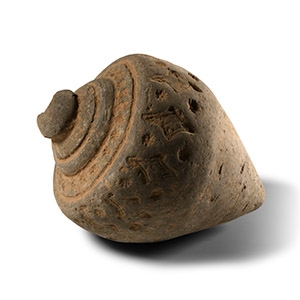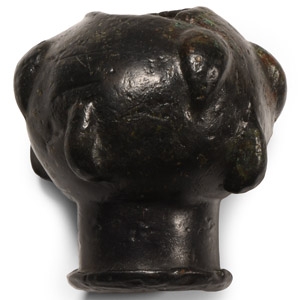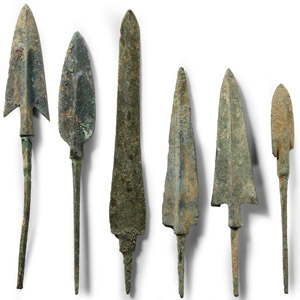Home > Auctions > 4 June - 8 June 2024
Ancient Art, Antiquities, Natural History & Coins
Auction Highlights:
Acquired York Antiques, Yorkshire, UK, in 2012.
Property of a Kent lady collector.
Accompanied by an original certificate of authenticity signed by Garry Edwards.
From a specialist collection of militaria, London, UK, collected 1990s onwards.
Accompanied by an academic paper by military specialist Dr Raffaele D'Amato, dated 15 July 2019 and titled 'Eastern Roman Empire - Greek Fire Bomb or Hand Grenade (μεσαίον kακάβιον) 9th-11th century AD'.
Cf. Arendt, W. I., Granaten des 13-14. Jahrhunderts, die an der Wolga gefunden sind, Zeitschrift fur Historische Waffen-und Kostumkunde, 11 (1926-8), p.42; cf. Arendt, W., Die Spharisch-konischen Gefäße aus Gebranntem Ton, ibid; cf. Ayalon, D., Gunpowder and Firearms in the Mamluk Kingdom, London, 1956, p.16.
Apart from the use of siphons or manual flame-throwers called cheirosiphona, special corps of Roman soldiers employed terracotta grenades, in the form of small jars, abundantly evidenced in archaeological excavations. They were called μεσαία kακαβιά or κυτροκακάβια where the former had a bulbous shape and the latter a more cylindrical form.
From a specialist collection of militaria, London, UK, collected 1990s onwards.
Accompanied by an academic paper by military specialist Dr Raffaele D'Amato, dated 15 July 2019 and titled 'Eastern Roman Empire - Greek Fire Bomb or Hand Grenade (μεσαίον kακάβιον) 9th-11th century AD'.
Cf. Arendt, W. I., Granaten des 13-14. Jahrhunderts, die an der Wolga gefunden sind, Zeitschrift fur Historische Waffen-und Kostumkunde, 11 (1926-8), p.42; cf. Arendt, W., Die Spharisch-konischen Gefäße aus Gebranntem Ton, ibid; cf. Ayalon, D., Gunpowder and Firearms in the Mamluk Kingdom, London, 1956, p.16.
Apart from the use of siphons or manual flame-throwers called cheirosiphona, special corps of Roman soldiers employed terracotta grenades, in the form of small jars, abundantly evidenced in archaeological excavations. They were called μεσαία kακαβιά or κυτροκακάβια where the former had a bulbous shape and the latter a more cylindrical form.
Found S.E. England, UK.
Acquired from Allan Cherry, Bournemouth, UK, circa 2004.
Ian Wilkinson collection, Nottinghamshire, UK.
Cf. for the ferrule Marchant, D.J., Roman weaponry in the province of Britain from the second century to the fifth century AD, Durham, 1991, plate 14, nos.3-4; for the javelin head fig.15, no.1.
The usual form of the butt of the spears in this period was a cone shape, sometimes split down one side, but more often forged into a complete circle. The butt was fastened to the wooden shaft by one or more rivets. The butt or ferrule of the Roman spears essentially had two functions. Firstly it acted as a counterweight to the blade of the spear/javelin, ensuring that the weapon was balanced and therefore effective. Secondly, it kept the wooden shaft out of contact with the ground if the spear was grounded and thus avoiding damage to it.
From a specialist collection of militaria, London, UK, collected 1990s onwards.
Accompanied by an academic paper by military specialist Dr Raffaele D'Amato, dated 15 July 2019 and titled 'Eastern Roman Empire - Greek Fire Bomb or Hand Grenade (μεσαίον kακάβιον) 9th-11th century AD'.
Cf. Arendt, W. I., Granaten des 13-14. Jahrhunderts, die an der Wolga gefunden sind, Zeitschrift fur Historische Waffen-und Kostumkunde, 11 (1926-8), p.42; cf. Arendt, W., Die Spharisch-konischen Gefäße aus Gebranntem Ton, ibid; cf. Ayalon, D., Gunpowder and Firearms in the Mamluk Kingdom, London, 1956, p.16.
Apart from the use of siphons or manual flame-throwers called cheirosiphona, special corps of Roman soldiers employed terracotta grenades, in the form of small jars, abundantly evidenced in archaeological excavations. They were called μεσαία kακαβιά or κυτροκακάβια where the former had a bulbous shape and the latter a more cylindrical form.
Ian Wilkinson collection, Nottinghamshire, UK, formed since 1985.
Accompanied by a handwritten provenance note.
Found near Wetwang, East Yorkshire, UK.
Acquired circa 2005.
Ian Wilkinson collection, Nottinghamshire, UK.
Cf. Swanton, M.J., Spearheads of the Anglo-Saxon Settlements, London, 1973, fig.18(c).
Exhibited at Harwich Museum, Harwich, Essex, UK, 14th March-9th June 2024; accompanied by a copy of a photograph of the artefact on display.
The chronological range of the type D1 extends over the entire Pagan period. With the group C1, of which Swanton believed this might simply be a long-socketted variant, the typology did not survive the 7th century A.D.
Acquired in the 1990s.
Ex Private collection, Suffolk, UK.
Property of a Kent lady collector.
Cf. Bikic, V., Beyond the Jewellery: Archer’s Rings in the Medieval Balkans (14th-15th centuries) in Bosselmann-Ruickbie, A. (ed.), New Research on Late Byzantine Goldsmiths’ Works (13th-15th Centuries), Mainz, 2019, figs.5, 6, 7.
From a specialist collection of militaria, London, UK, collected 1990s onwards.
Accompanied by an academic paper by military specialist Dr Raffaele D'Amato, dated 15 July 2019 and titled 'Eastern Roman Empire - Greek Fire Bomb or Hand Grenade (μεσαίον kακάβιον) 9th-11th century AD'.
Cf. Arendt, W. I., Granaten des 13-14. Jahrhunderts, die an der Wolga gefunden sind, Zeitschrift fur Historische Waffen-und Kostumkunde, 11 (1926-8), p.42; cf. Arendt, W., Die Spharisch-konischen Gefäße aus Gebranntem Ton, ibid; cf. Ayalon, D., Gunpowder and Firearms in the Mamluk Kingdom, London, 1956, p.16.
Apart from the use of siphons or manual flame-throwers called cheirosiphona, special corps of Roman soldiers employed terracotta grenades, in the form of small jars, abundantly evidenced in archaeological excavations. They were called μεσαία kακαβιά or κυτροκακάβια where the former had a bulbous shape and the latter a more cylindrical form.
Acquired 1980-2015.
Ex Abelita family collection.
From the private collection of a London gentleman, from his grandfather's collection formed before the early 1970s.
Cf. Arbman, H., Birka I: Die Gräber, Uppsala, 1940, grave 735, for type.
Acquired 1980-2015.
Ex Abelita family collection.
1165 - 1176 of 2809 LOTS

.jpg)

.jpg)
.jpg)
.jpg)
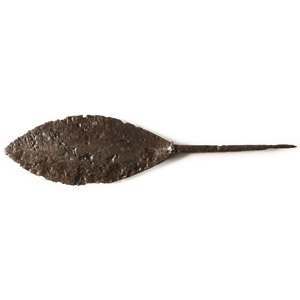
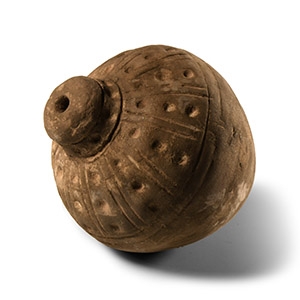
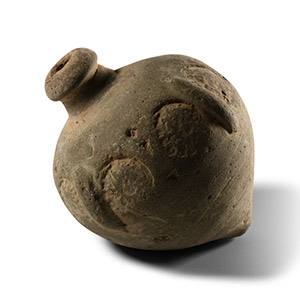
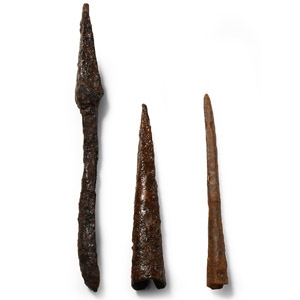

.jpg)
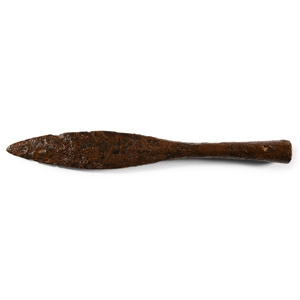
.jpg)
